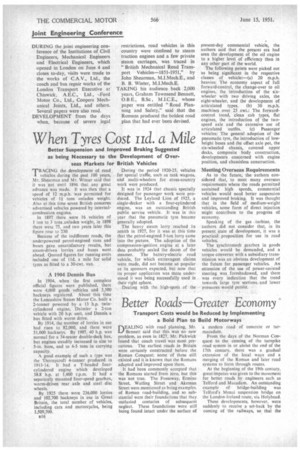When Tyres Cost rid. a Mile
Page 50

If you've noticed an error in this article please click here to report it so we can fix it.
Better Suspension and Improved Braking Suggested as being Necessary to the Development of Overseas Markets for British Vehicles
TRACING the development of road 1 vehicles during the past 100 years, Mr. Shearman and Mr. Winter said that it was not until 1896 that any great advance was made. It was then that a speed of 12 m.p.h. was permitted for vehicles of 1 tons unladen weight. Also at this time seven British concerns advertised vehicles powered by internalcombustion engines.
In 1897 there were 16 vehicles of 1 ton to 3 tons .unladen weight, in 1898 there were 75, and two years later this figure rose to 230 Because of the indifferent roads, the underpowered petrol-engined vans and buses gave unsatisfactory results, but steam-driven lorries and buses went ahead. Quoted figures for running costs included one of lid, a mile for solid tyres as fitted to a 30-cwt. van.
A 1904 Dennis Bus In 1904, when the first complete official figures were published, there were 4,000 goods vehicles and 5,300 hackneys registered. About this time the Lancashire Steam Motor Co. built a 2-tonner powered by a 13 h.p. twincylindered engine, Daimler a 2-ton vehicle with 20 h.p. unit, and Dennis a bus fitted with worm drive.
By 1914, the number of lorries in use had risen to 82,000, and there were 51,000 hackneys. By 1907, 40 h.p. was normal for a 34-seater double-deck bus, but engines steadily increased in size to 5-in, bore, and to 4-5 tons in carrying capacity.
A good example of such a type was the Thorn ycroft 4-tonner produced in 1913-14. It had a T-headed fourcylindered engine which developed 38.8 h.p. at 1,400 r.p.m. It had a separately mounted four-speed gearbox, worm-driven rear axle and steel disc wheels.
By 1925 there were 236,000 lorries and 102,700 hackneys in use in Great Britain, the total number of vehicles, including cars and motorcycles, being 1,509,700.
B16 During the period 1920-25, vehicles for special traffic, such as tank wagons, and multi-wheelers for cross-country work were produced.
It was in 1924 that chassis specially designed for passenger work were produced. The Leyland Lion of 1925, a single-decker with a four-cylindered engine, was an outstanding British public service vehicle. It was in this year that the pneumatic tyre became generally adopted.
The heavy steam lorry reached its zenith in 1927, for it was at this time that the petrol-engined 5-ton lorry came into the picture. The adoption of the compression-ignition engine at a later date probably sealed the doom of the steamer. The battery-electric road vehicle, for which extravagant claims were made, did not become so popular as its sponsors expected, but now that its proper application was more understood it was being successfully used in their right sphere.
Dealing with the high-spots of the present-day commercial vehicle, the authors said that the present era had seen the development of the oil engine to a higher level of efficiency than in any other part of the world.
The following points were picked out as being significant in the respective classes of vehicle:—(a) 20 m.p.h. heavies: The economy aspect of full forward-control, the change-over to oil engines, the introduction of the sixwheeler with two driving axles, the eight-wheeler, and the development of articulated types. (b) 30 m.p.h. machines over 25 cwt.: The forwardcontrol trend, clean cab types, flat engines, the introduction of the twospeed axle and the extensive use of articulated outfits. (c) Passenger vehicles: The general adoption of the pneumatic tyre, the introduction of lowheight buses and the offset axle pot, the six-wheeled chassis, covered upper decks, composite body construction, developments concerned with engine position, and chassisless construction.
Meeting Overseas Requirements
As to the future, the authors considered that, to meet many overseas requirements where the roads permitted sustained high speeds, commercial vehicles would need better suspension and improved braking. It was thought that in the field of medium-weight vehicles, some form of direct injection might contribute to the progress of economy.
Speaking of the gas .turbine, the authors did not consider that, in its present state of development, it was a practical proposition for use in road vehicles.
The synchromesh gearbox in goods vehicles would be demanded, and a torque converter with a subsidiary transmission was an obvious development of the future for passenger vehicles. An extension of the use of power-assisted steering was foreshadowed, and there was every indication that the trend towards large tyre sections and lower pressures would persist.




























































































